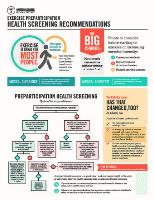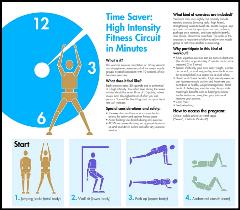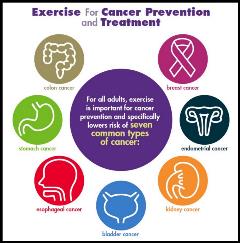ACSM Certification Department |
Feb.
1, 2018

Risk stratification, risk classification and preparticipation screening explained.
Public health officials have long encouraged adults to be physically active on most, if not all, days of the week to realize the many health benefits associated with regular exercise. At the same time, exercise professionals have been taught that preparticipation health screening was necessary to identify those individuals with certain known risk factors for an unexpected event during or immediately after exercise. To accomplish this, exercise preparticipation screenings were developed, resulting in risk stratification models (now risk classification models).
"...exercise preparticipation screenings were developed, resulting in risk stratification models (now risk classification models)."
Risk classification allows the exercise professional to identify individuals with cardiovascular or pulmonary disease, or those at risk for sudden cardiac death (SCD) or other life-threatening conditions. Through classification protocols, at-risk individuals would be referred to a physician for medical testing and clearance before starting an exercise program.

Risk classification became a best practice for exercise preparticipation screening and has been used broadly to determine who is safe to start exercising and who needs to seek medical clearance. However, as public health efforts encouraging regular physical activity have increased over the past few decades, there has been an associated effort to identify barriers keeping people from starting exercise. One area thought to be a substantial limiting factor in these efforts to increase physical activity (PA) participation was an over-prescription for medical clearance prior to participation.
In 2014, Whitfield and colleagues published a paper using a long-recommended preparticipation health screening checklist. Based on their findings, they concluded that nearly 95 percent of men and women older than 40 years of age would be directed to consult a physician before engaging in any form of exercise. This practice likely leads to a needless referral to a health care provider, thereby creating a burden to an individual who wants to begin exercise -- even something as simple as walking.
Consequently, ACSM convened a scientific round table in June of 2015 to evaluate, refine and define its exercise preparticipation health screening procedures; the updated recommendations of this expert panel were published. For a determination about whether medical referral is recommended or not, these new screening guidelines rely on the following:
- current exercise participation
- history and symptoms of cardiovascular, metabolic or renal disease
- the desired exercise intensity for the person who wants to initiate a PA program.
The purpose of our paper was to compare the referral proportion of the new ACSM algorithm to that of previous screening tools in the same representative sample of US adults used in the original Whitfield et al. paper (NHANES data). Our results demonstrated that the number of individuals who would be referred to a physician before beginning exercise was decreased by approximately 41 percent. This finding suggests that the new prescreening procedures have achieved the intended outcome - decreasing the barriers to PA participation by decreasing the number of individuals who require medical clearance prior to engagement.
Further information for exercise professionals regarding preparticipation screening:
Authors
Gary Liguori, Ph.D., FACSM, is the dean of the College of Health Sciences and a professor of kinesiology at the University of Rhode Island in Kingston, Rhode Island. He also was an associate editor of the 10th edition of ACSM's Guidelines for Exercise Testing and Prescription (GETP10).
Meir Magal, Ph.D., FACSM, is the chair of the School of Mathematics and Sciences and an associate professor of exercise science at North Carolina Wesleyan College in Rocky Mount, North Carolina. He also served as an associate editor of GETP10.
Deborah Riebe, Ph.D., FACSM, is the associate dean of the College of Health Sciences and a professor of kinesiology, at the University of Rhode Island in Kingston, Rhode Island. Dr. Riebe was the senior editor of GETP10.
Download More Popular ACSM Resources

7 Minute Workout | Download

Exercise for Cancer Prevention and Treatment